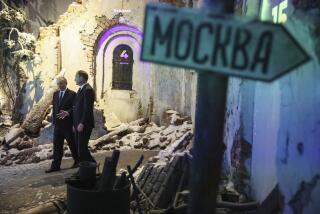Soviets Still Plan to Push Nuclear Power Output
- Share via
MOSCOW — Soviet Premier Nikolai I. Ryzhkov confirmed Wednesday that the Kremlin plan to double nuclear power output by 1990 will go ahead despite the Chernobyl nuclear disaster.
He told the 1,500 deputies of the Supreme Soviet, the national legislature, that nuclear power has been a growing part of the Soviet energy picture in recent years and emphasized “the correctness of such a road,” according to a summary of the speech carried by the official news agency Tass.
Ryzhkov referred to the April 26 reactor explosion and fire at the Ukrainian power plant, which resulted in the deaths of at least 26 people and hospitalized hundreds, as evidence that strict safety measures must be observed.
“The determination of a technical policy which ensures a high reliability of nuclear power stations is of importance here as in no other sector,” he said. “The accident at the Chernobyl nuclear power station has shown the exceptional importance of the observance of such requirements.”
Chernobyl raised doubts about nuclear plant safety among many Westerners, but Soviet officials have said repeatedly that plans for more nuclear power generation will go ahead and no major changes are planned in reactor design.
Andronik M. Petrosyants, head of the government atomic energy agency, told a news conference early in May that the accident will not deter plans to expand and improve nuclear power production.
The Soviet Union now gets about 10% of its electricity from nuclear power. The five-year economic plan unveiled at the 27th Communist Party Congress that ended in March calls for 20% by 1990.
That plan is to be approved at the current session of the Supreme Soviet, which opened Wednesday.
Planners have focused attention on nuclear power over the last two decades to make up for declining fossil fuel reserves in the western areas of the country.
The Soviet Union is the world’s largest producer of gas and oil, but oil production has declined steadily in the past two years, and the most fuel reserves are in Siberia.
More to Read
Sign up for Essential California
The most important California stories and recommendations in your inbox every morning.
You may occasionally receive promotional content from the Los Angeles Times.












